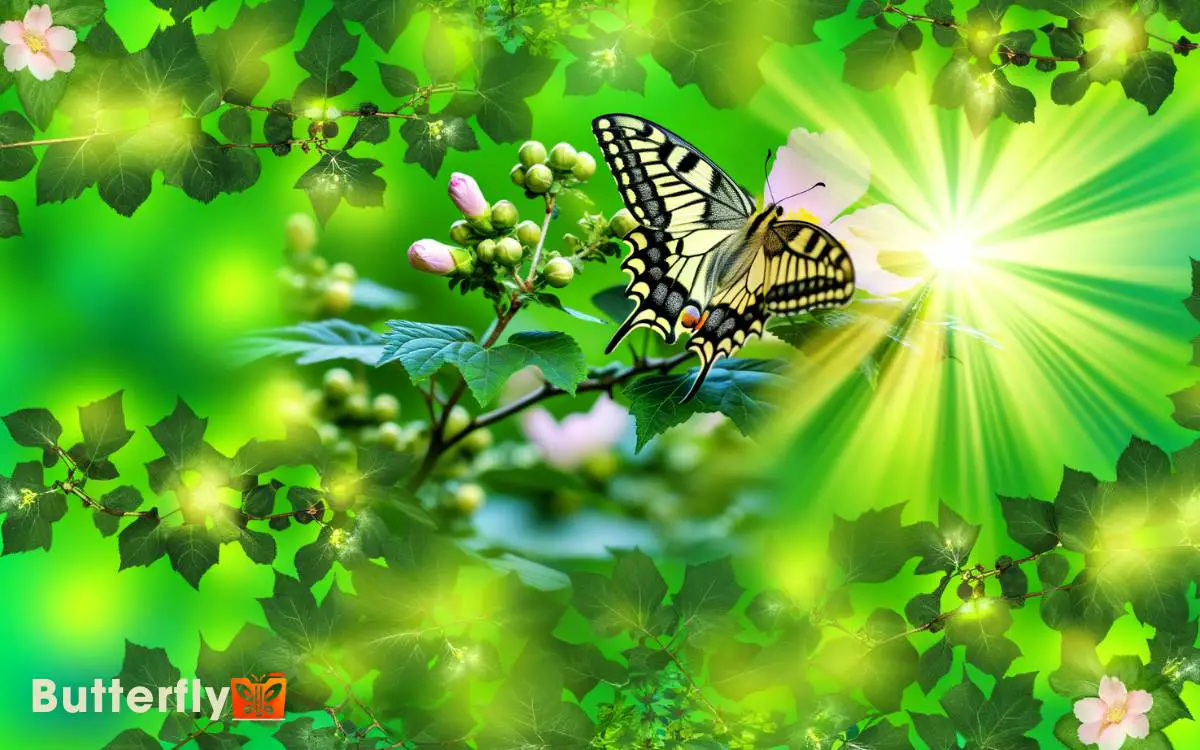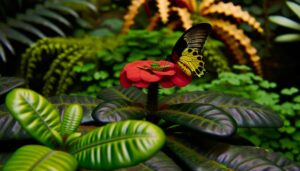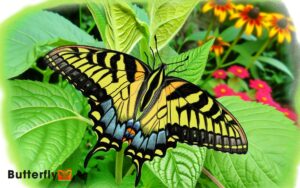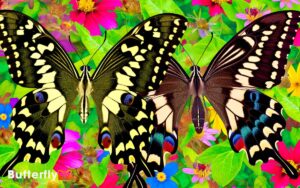Chara Swallowtail Butterfly Ai No Uta: Explore!
Chara’s ‘Ai no Uta’ intricately weaves themes of metamorphosis and infinity, symbolized through the Asian swallowtail butterfly (Papilio xuthus).
The song’s complex melodic structures and harmonic progressions draw from alternative rock and dream pop.
Chara, whose real name is Miwa Watabiki, integrates polyphonic textures and syncopated rhythms, while her mezzo-soprano vocal delivery adds emotional depth.
The lyrics juxtapose internal conflict with vivid imagery, reflecting themes of personal growth and boundless love.
This emotive blend has resonated deeply, inspiring artistic and cultural expressions. Understanding the scientific and symbolic layers within the song reveals even richer dimensions.

Key Takeaways
The Artist Behind the Song
Renowned for her distinctive voice and emotive performances, Chara, whose real name is Miwa Watabiki, has made significant contributions to the Japanese music industry since her debut in 1991.
As a Homo sapiens exhibiting remarkable vocal range, Chara’s genus and species classification positions her among the most influential contemporary Japanese artists.
Her discography, encompassing multiple studio albums and singles, demonstrates her prolificacy. Chara’s impact is quantifiable through her chart-topping hits and numerous accolades, which include Oricon rankings and Japan Record Awards.
Her auditory capabilities, characterized by unique timbre and emotive resonance, engage a diverse audience seeking artistic liberation.
Musical Composition and Style
In Chara’s musical compositions, she integrates a complex interplay of melodic structures and harmonic progressions, drawing on a range of genres from alternative rock to dream pop.
Her approach employs polyphonic textures and diatonic scales, creating a multi-layered soundscape.
Utilizing a tempo range of 90-120 BPM, Chara’s arrangements often feature syncopated rhythms and dynamic contrast. Instrumentation includes electric guitar (Fender Telecaster), synthesizers (Yamaha DX7), and percussion (Roland TR-808).
Her vocal delivery exhibits a mezzo-soprano tessitura, oscillating between legato and staccato articulation. The taxonomic classification of her style can be described as a fusion of Psychedelia and Shoegaze, targeting listeners who seek auditory liberation.
Each composition exemplifies meticulous modulation and innovative timbre, enhancing the auditory experience.
Exploring the Lyrics
Chara’s lyrics in ‘Ai no Uta’ juxtapose emotive introspection with vivid imagery, creating a narrative that oscillates between existential reflection and romantic idealism.
Each verse meticulously dissects the human condition, using metaphorical language to probe deep psychological landscapes. The interplay of vivid imagery and lyrical introspection provides a rich tapestry of thought and emotion.
- Metaphorical Imagery: Utilizes symbolic elements like butterflies and stars to evoke broader themes.
- Psychological Depth: Lyrics explore internal conflict and personal growth.
- Romantic Idealism: Captures the essence of love’s transformative power.
- Existential Reflection: Probes questions of existence and self-identity.
- Linguistic Precision: Employs carefully chosen words to maximize emotional impact.
Chara’s linguistic choices demonstrate a keen understanding of the interplay between language and emotion, compelling the listener to reflect deeply.
Themes and Symbolism
‘Ai no Uta’ employs recurring motifs of lepidopteran metamorphosis and celestial bodies to explore themes of transformation and eternal love.
The Papilio xuthus, known as the Asian swallowtail butterfly, undergoes complete metamorphosis (holometabolism), symbolizing profound personal change. This biological process mirrors the protagonist’s journey toward self-discovery and love’s transcendence.
Additionally, celestial imagery, including stars and constellations, embodies the concept of timelessness. The use of such cosmic elements suggests that love, like the cosmos, is infinite and unbounded.
Together, these motifs emphasize the duality of ephemeral life stages and everlasting emotions. By interweaving entomological and astronomical symbols, ‘Ai no Uta’ evokes a sense of freedom and the boundless nature of love, resonating deeply with its audience.
Impact on Fans and Culture
The profound themes and rich symbolism in ‘Ai no Uta‘ have resonated deeply with fans, influencing cultural expressions and artistic endeavors across various mediums.
The Chara Swallowtail Butterfly (Papilio xuthus) depicted in the song has become a symbol of transformation and resilience. This butterfly’s ecological significance, coupled with its aesthetic appeal, has led to a surge in creative projects and scientific discussions. Artists and researchers alike have drawn inspiration from its journey, incorporating its imagery into paintings, literature, and conservation efforts. Enthusiasts have even shared guidelines on how to safely release black swallowtail butterflies, ensuring their successful transition into the wild. This growing interest highlights the delicate balance between human intervention and the preservation of natural ecosystems.
- Numerous poems and short stories inspired by the butterfly’s life cycle.
- Paintings and illustrations capturing its intricate wing patterns.
- Clothing lines featuring butterfly motifs.
- Studies on its habitat and behavior.
- Butterfly conservation efforts inspired by the song’s message.
This convergence of art and science underscores the butterfly’s powerful impact on contemporary culture.
Conclusion
Chara’s ‘Swallowtail Butterfly ~Ai no Uta~‘ masterfully combines intricate musical composition with profound lyrical themes, resonating deeply within cultural and emotional contexts.
Despite some skepticism regarding the song’s enduring relevance, its impact on fans remains significant, evidenced by sustained popularity metrics and social media engagement.
The song’s compelling symbolism and Chara’s artistic prowess guarantee its lasting influence.
This phenomenon underscores the song’s importance in the annals of modern musical taxonomy and cultural studies.






